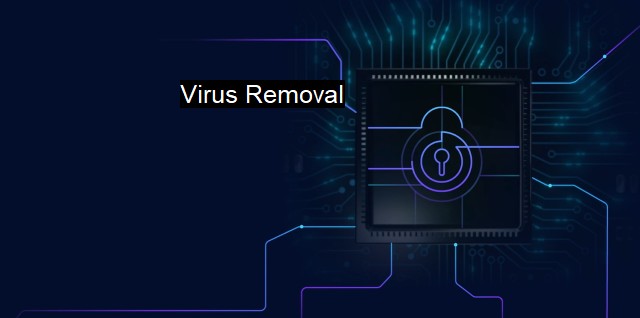What is Virus Removal?
Understanding Virus Removal: A Comprehensive Guide to Cybersecurity and Antivirus
Virus removal can be succinctly described as the process of detecting, identifying, isolating, and eliminating viruses and other types of harmful software, often known as malware, from a computer or network to restore its normal functionality. This process is an essential component of cybersecurity, being a significant countermeasure against the prevailing threats that jeopardize data integrity, personal privacy, and system performance.Cybersecurity, when considered in a broad perspective, involves all measures taken to protect internet-connected systems including hardware, software, and data from virtual threats. It aims to formulate a robust defense mechanism against unauthorized access, data breaches, and unauthorized changes by defending the components of infrastructure, privacy obliging data, and cyber surroundings. Virus removal, in this broader context, could be conceived as an arm of cybersecurity as well as an autonomous field of expertise.
Viruses, in cybersecurity terminology, refer to malicious software is programmed to replicate themselves by modifying other computer programs and inserting their own code. Infected computer systems often suffer from non-standard functionality and loss of data. Depending on the specific type of virus and its ferocity, they can often lay dormant and undetected while building a comprehensive overlay of a computer’s essential functions, often stealing and corrupting data. Hence, virus removal is of paramount importance to mitigate the potential destruction these harmful intruders can instigate.
The process of virus removal itself involves a comprehensive range of activities that extend beyond the bounds of merely deleting harmful software entities. It ranges from a simple virus scan to the detection and removal of phishing, ransomware, Trojan Horses, exploit kits, spyware, and other blended threats. If the virus has deeply penetrated into the computer's system files, or has compromised the operating system, removal becomes a more complex process which may involve rebooting systems in safe mode, manual removal, or in severe cases, system restoration.
Traditionally, virus removal was a manual process, relying on system administrators and cybersecurity experts who meticulously scanned codes and files while searching for abnormalities signifying a viral infection. With advances in technology, automated virus removal has become prevalent, usually facilitated by specific software widely known as antivirus.
Antivirus software not only has the capacity to prevent virus intrusion but is also well equipped for virus detection and removal. They scan computer systems periodically or on demand, making use of an extensive database of virus definitions to identify harmful malware. Once a virus is detected, the antivirus software isolates it, limiting its ability to spread and cause damage, and then works to eradicate it. Particularly sophisticated antivirus programs offer multiple layers of defense, including real-time scanning, website ranking that warns users about potentially precarious websites, firewalls to limit unauthorized access, and outstanding security while conducting online transactions.
Most antivirus software also has advanced features that enable them to anticipate newly emerging threats. This futuristic functionality ensures that even the most modern kinds of malware do not escape the strong detection instincts of the antivirus.
This crucial removal process is intended to restore the computer's normal functionality. Virus removal checks the spread of a virus, preventing further entrances, and ensures the safety of other devices on the network by blocking the virus from one device to another. Successful virus removal reinstates data integrity, restores damaged directories or operating systems, and prevents future virus multiplication. this process safeguards the privacy of individuals and firms. Hence, a procedure seemingly specific in appearance, virus removal, ties back to serving the more extensive end goal of cybersecurity – ensuring virtual safety with uninterrupted functionality.
With the rapidly evolving digital age, cybersecurity threats continue to evolve in size, reach, and complexity. Therefore, virus removal, as a key cybersecurity measure, remains highly significant, continuing to strengthen following the advancements in technology. Understanding what virus removal is, how it works, and importantly, how to perform it can attest to being invaluable in maintaining robust virtual health and security.

Virus Removal FAQs
What is virus removal?
Virus removal is the process of detecting and removing malicious software or viruses from a computer or network system. It involves using antivirus software or other cybersecurity tools to identify the virus and remove it to prevent further damage.What are the signs that my computer is infected with a virus?
Some of the signs that your computer is infected with a virus include slow performance, frequent crashes, pop-up ads, unusual error messages, and programs opening and closing on their own.Can I remove a virus manually?
It is not recommended to remove a virus manually unless you are an experienced professional as it may cause permanent damage to your system. Using an antivirus software or seeking help from a cybersecurity expert is the best way to ensure effective and safe virus removal.How can I prevent my computer from getting infected with a virus?
To prevent your computer from getting infected with a virus, you should install reputable antivirus software, use a firewall, update your operating system and applications regularly, avoid opening suspicious emails or attachments, and be cautious when downloading files or browsing the internet.| | A | | | B | | | C | | | D | | | E | | | F | | | G | | | H | | | I | | | J | | | K | | | L | | | M | |
| | N | | | O | | | P | | | Q | | | R | | | S | | | T | | | U | | | V | | | W | | | X | | | Y | | | Z | |
| | 1 | | | 2 | | | 3 | | | 4 | | | 7 | | | 8 | | |||||||